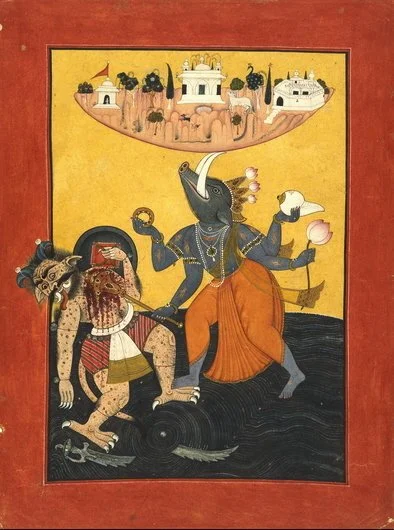Rahu's Transit into Uttara Bhādrapadā: Unveiling the Depths of the Subconscious
Artwork from Pinterest
The shadowy graha Rāhu, depicted as mounted on a lion, bluish-black and smoke in color, residing in the forest, eclipser of the luminaries, karaka (significator) of justice, courage, and mission, often associated with rebellion, the foreigner, and protector of Earth, enters the constellation of Uttara Bhādrapadā (sidereal Pisces), the Warrior Star, on July 8th.
Rahu's transit into Uttara Bhādrapadā, in the sidereal sign of Pisces, marks a profound journey through the realm of the unconscious. This lunar mansion, symbolized by the back of a funeral cot and a serpent of the deep, evokes a deep connection to the cycles of life and death, the fertility of both earth and sky. It is here, in the domain of Uttara Bhādrapadā, that Rahu weaves his enigmatic influence, guiding us to delve into the depths of our subconscious, to unearth hidden truths and embrace the wisdom that lies therein.
As Rahu traverses this celestial pathway, we are invited to harmonize with universal mind, to align our personal will with the greater cosmic order. This transit calls for introspection and a willingness to confront our shadows, to navigate the murky waters of our psyche with humility and self-sacrifice. It is through this process of excavation that we gain profound insights, transforming our inner landscape and fostering a deeper connection to the divine.
Uttara Bhādrapadā, ruled by the wise Saturn and situated in the realm of Jupiter, presents a dual energy, represented by the twin fishes swimming in the ocean of consciousness. This nakshatra embodies the duality of existence, the constant interplay between the spiritual and the material realms. It is the hero’s journey, marked by struggle, protection, and service, where the kshatriya spirit fights to find meaning and purpose amidst life’s challenges.
Within this nakshatra lies the wisdom of the serpent, a mystical force dwelling beneath the waters, carrying the ancient knowledge of Pisces. As Rahu enters this domain, the seeker encounters the serpent, embodying both wisdom and danger. The serpent’s bite, a metaphor for life’s trials, releases the poison of the material world, purging the toxins that hinder spiritual growth. This transformative pain is the catalyst for enlightenment, leading to moksha, the ultimate liberation.
Rahu, the asura who moves backward (heyoka energy), embodies the restless quest for knowledge and experience. In Uttara Bhādrapadā, Rahu’s influence is both malevolent and enlightening, revealing the illusions of the material world while urging us to create something meaningful from limited resources. This transit challenges us to confront our limitations, to embrace Saturn’s teachings of patience, resilience, and the practical wisdom of making the most of what we have.
As Rahu matures at 42, the struggle to balance the material and spiritual realms culminates in a profound realization. The trials faced, the poison endured, all contribute to the seeker’s journey towards enlightenment. It is through these experiences that we learn to transcend our earthly limitations, discovering the boundless potential within.
For those running a Dasha or sub-period of Rahu, or having natal planets in Uttara Bhādrapadā, the impact of this transit will be especially profound. The energies of Rahu will be strongly felt, intensifying the journey through the subconscious and magnifying the experiences of transformation and revelation. This period can bring about significant changes, urging a deeper exploration of one's inner world and a reevaluation of life's direction.
During this transit, let us remain steadfast in our spiritual pursuits, honoring the lessons of the past and preparing for the rebirth that follows the dissolution of the old. As we navigate Rahu’s passage through this mystical nakshatra, we attune to the subtle currents of our inner world, embracing the transformative power of introspection. In doing so, we open ourselves to the boundless wisdom of the cosmos, harmonizing our soul’s journey with the eternal dance of creation and dissolution.
For more personalized guidance on this long, impactful transit, know that I am here to support you and do offer one-on-one Vedic Astrology readings, which you can book here.




